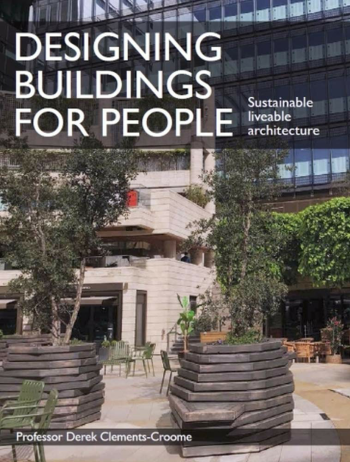Designing Buildings for People

|
| Designing Buildings for People, Derek Clements-Croome, 2020, 208 pages, 272 colour and six black-and-white illustrations. |
The pandemic has opened our eyes to the benefits of more adaptable working environments. For those involved in planning and architecture, whether new build or refurbishment, this requires greater openness to new ideas alongside awareness of long-term consequences. As we strive to meet challenging targets concerning climate change, it is easy to overlook the quality of life of buildings’ inhabitants. In ‘Designing Buildings for People’, Derek Clements-Croome shows how more holistic approaches can be achieved.
His model is the ‘intelligent building’, one that is technologically driven but designed for the health and wellbeing of its occupants, where a humane approach offsets the hard face of technology and construction. Intelligent buildings have existed for thousands of years – the igloo, wind towers, Japanese tea house and east Asian courtyard buildings have provided durability, resilience, function and beauty, the present-day equivalents of Sir Henry Wooton’s ‘firmness, commodity and delight’. Among the author’s prototypes are vernacular buildings that create harmony between the climate, architecture and people, and one of the chapters is devoted to what such buildings can teach us.
Another chapter covers biomimetics, which are concerned with mimicking functional systems found in nature. Examples are works by Pier Luigi Nervi and Frei Otto, who looked at shells, domes and webs, the Eden Project or Arup’s remarkable Bio Intelligent Quotient Building in Hamburg, the first algae-powered building in the world.
The need to foster wellbeing has commanded attention of late, and together with a complementary chapter on sustainability, this forms the core of the book. Wellbeing reaches beyond health, catering for the spirit as well as the body. It is also at the root of human creativity and productivity, and even such basic things as layout and arrangement of spaces in buildings that influence communication between people can have a major effect.
For the author, technology is an essential enabler, where the Internet of Things, artificial intelligence, robotics, Blockchain and new materials all have a role to play. But in a caveat he quotes Klaus Schwab, founder of the World Economic Forum: ‘The Fourth Industrial Revolution can compromise humanity’s traditional sources of meaning – work, community, family and identity – or it can lift humanity into a new collective and moral consciousness based on a sense of shared destiny. The choice is ours.’
A chapter follows on the theme of decision-making, which advocates a ‘transdisciplinary’ approach to overcome endemic problems, such as silo-thinking culture, bureaucracy, short-termism, low-cost solutions rather than value, and poor connectivity in the supply chain, in order to achieve a consensus. This must embrace the voice of those involved in the historic environment.
An inspiring and diverse collection of case studies completes the book. It includes the White Collar Factory in London, recent work on Barcelona’s Sagrada Familia, the Design Museum conversion of the former Commonwealth Institute, the Gardens by the Bay, Singapore, the University of Chicago Library and a concept for homeless shelters. Something for everyone.
This article originally appeared as 'The choice is ours' in Context 169, published by the Institute of Historic Building Conservation (IHBC) in September 2021. It was written by Peter de Figueiredo, reviews editor of Context.
--Institute of Historic Building Conservation
Related articles on Designing Buildings
IHBC NewsBlog
Old Sarum fire in listed (& disputed) WW1 Hangar - Wiltshire Council has sought legal advice after fire engulfed a listed First World War hangar that was embroiled in a lengthy planning dispute.
UK Antarctic Heritage Trust launches ‘Virtual Visit’ website area
The Trust calls on people to 'Immerse yourself in our heritage – Making Antarctica Accessible'
Southend Council pledge to force Kursaal owners to maintain building
The Council has pledged to use ‘every tool in the toolbox’ if urgent repairs are not carried out.
HE’s Research Magazine publishes a major study of the heritage of England’s suburbs
The article traces the long evolution of an internal programme to research 200 years of suburban growth
IHBC Context 183 Wellbeing and Heritage published
The issue explores issues at the intersection of heritage and wellbeing.
SAVE celebrates 50 years of campaigning 1975-2025
SAVE Britain’s Heritage has announced events across the country to celebrate bringing new life to remarkable buildings.
IHBC Annual School 2025 - Shrewsbury 12-14 June
Themed Heritage in Context – Value: Plan: Change, join in-person or online.
200th Anniversary Celebration of the Modern Railway Planned
The Stockton & Darlington Railway opened on September 27, 1825.
Competence Framework Launched for Sustainability in the Built Environment
The Construction Industry Council (CIC) and the Edge have jointly published the framework.
Historic England Launches Wellbeing Strategy for Heritage
Whether through visiting, volunteering, learning or creative practice, engaging with heritage can strengthen confidence, resilience, hope and social connections.














